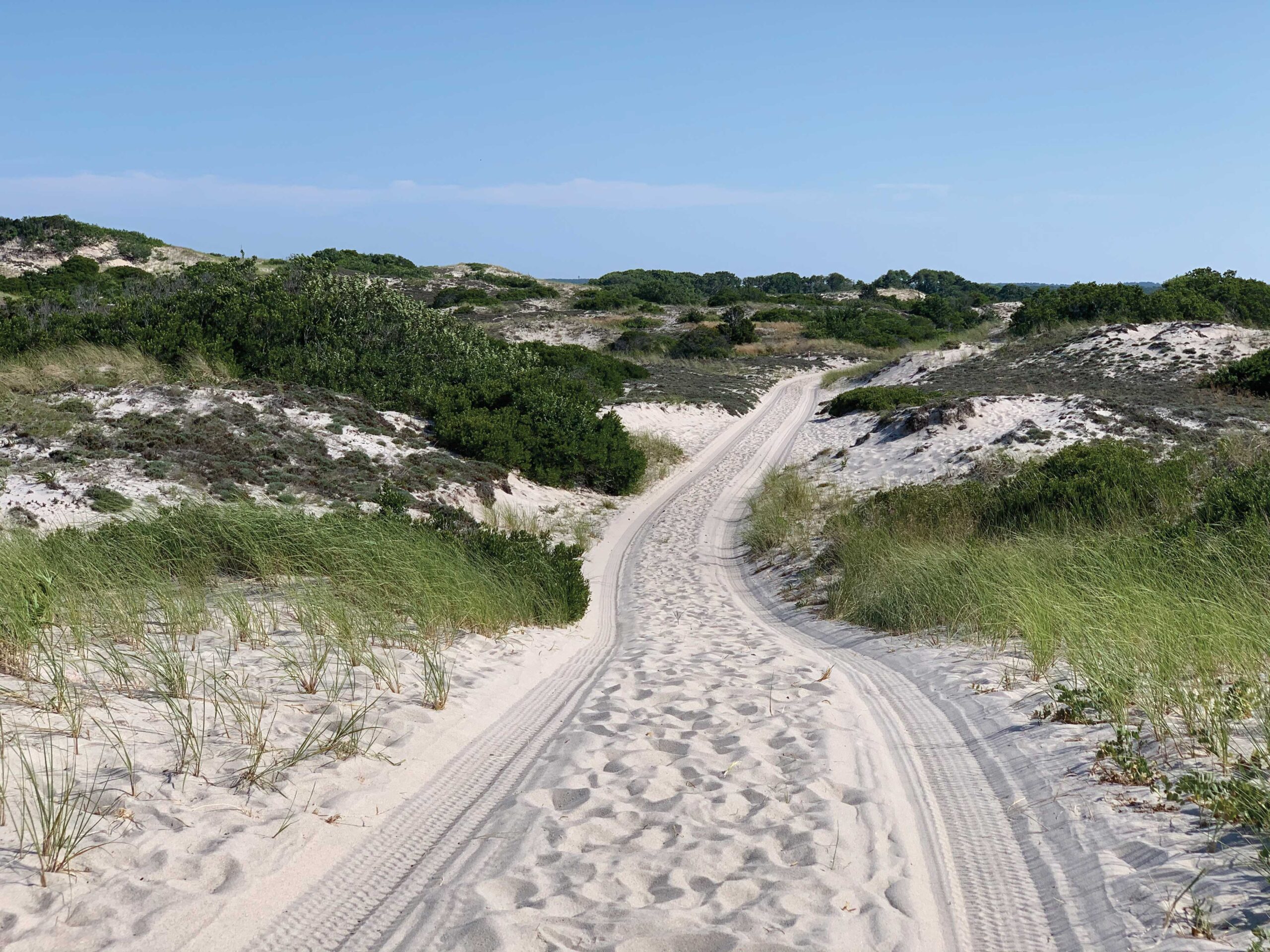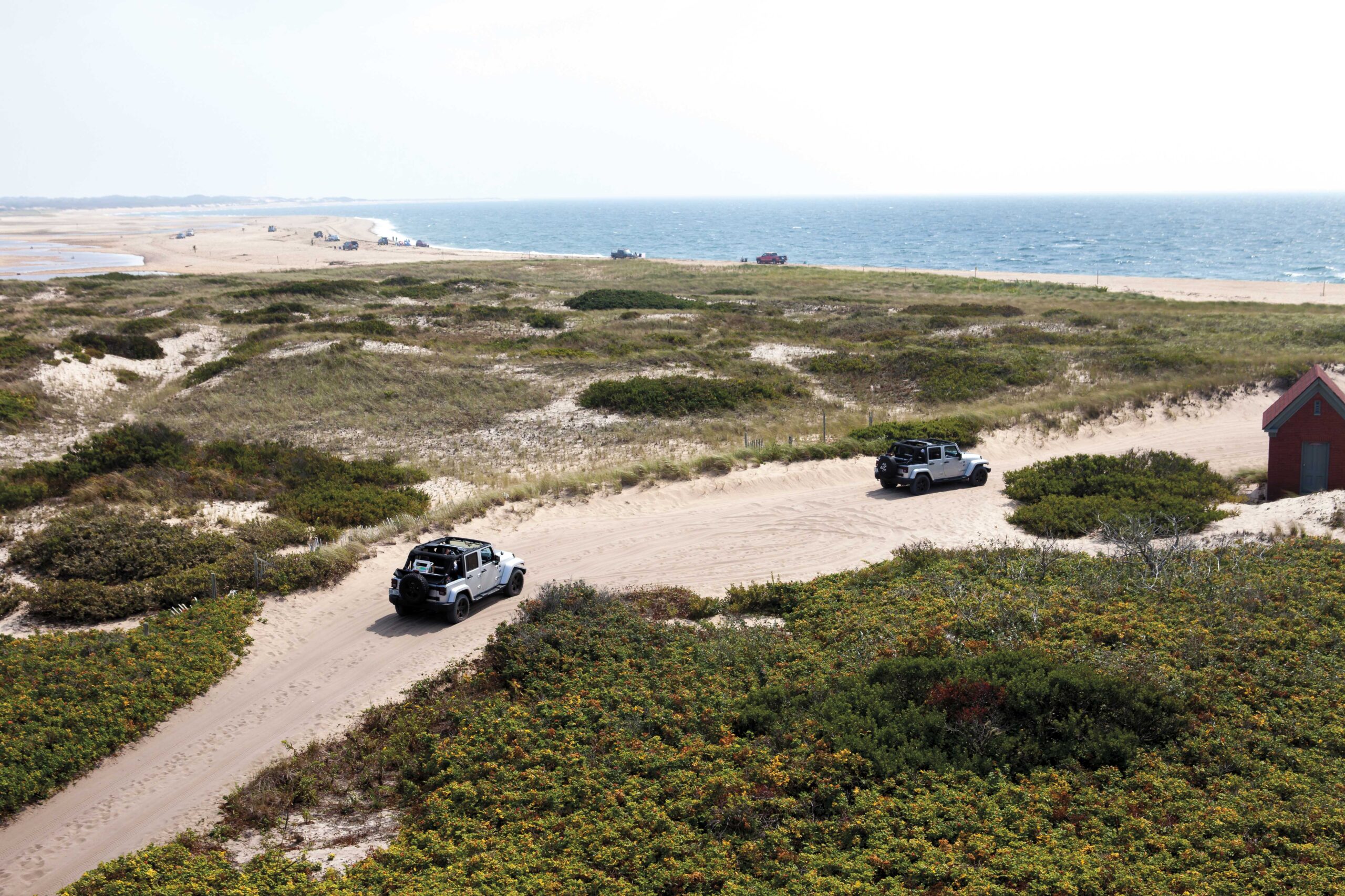Various Cape and island beaches offer residents and visitors the option of driving their vehicles onto the sand and away from the crowds for a beach day to remember.
by Alice Lesch Kelly
When sun and waves draw hordes of people to the beach this summer, you won’t find Orleans resident Ann Caplicki and her family in the line of cars waiting to enter the public parking lot at Nauset Beach. No, Caplicki won’t be parking her car and lugging chairs, umbrellas, picnic baskets, and towels across the pavement and down the beach in search of the perfect place to spend the day.
Instead, Caplicki and her family will load up their vehicle, drive directly onto Nauset Beach via an off-road entrance, and park right on the sand, just a few yards from the surf. Then they’ll set out their beach chairs and start enjoying their day, with everything they need right next to them in their vehicle. Caplicki and her family can do this because they have over-sand vehicle (OSV) permits issued by the Town of Orleans. These permits allow Caplicki and her family to drive their vehicles—a pickup truck and an all-wheel-drive SUV—on more than five miles of Orleans beaches. “I get an OSV permit every year,” says Caplicki. “It’s so much fun to drive out onto the beach.”
Everything they need for the day—games, fishing equipment, a cooler of food and drinks, a small gas grill to cook dinner, and even a portable toilet—is right there in their car, just a few feet from their beach chairs. “There’s so much room for people to have fun, and it’s a wonderful place to meet people, too. Everyone is social.”
Orleans is just one of several towns on the Cape and the islands that offers residents and visitors the opportunity to drive on the beach. OSV permits are also available in towns such as Barnstable, Chatham, Truro, Dennis, Nantucket, and Martha’s Vineyard. The Cape Cod National Seashore also sells off-road vehicle permits to drive on certain beaches. Some towns allow permit holders with self-contained vehicles (campers) to spend the night on the beach for up to a few days at a time (up to 96 hours in Orleans).


One of the best things about driving on the beach is that it can take you away from some of the ubiquitous throngs that crowd Cape and island beaches in the summer. “People love having their own little section of the beach to spread out,” says Brandon Burke, natural resources officer and beach director for the Town of Orleans. “It’s also a lot more convenient for elderly and handicapped people who can’t walk long distances on the sand.”
At Sandy Neck Beach Park in Barnstable, off-roaders can drive on up to 4.5 miles of beach, depending on the time of year. “People often tell me it’s their happy place,” says Nina Z. Coleman, director of natural resources and Sandy Neck park manager. “Some of these people have been gathering at Sandy Neck for years. They were born and raised spending summer nights camping there, and now they’re bringing their children there. It’s a very positive place, and it’s extremely popular.”
Last summer, when the pandemic caused people to cancel distant vacation plans and add social distancing to their beach day to-do lists, applications for OSV permits increased significantly. In Orleans, they went up 40 percent, says Burke.
There’s plenty to see in addition to unobstructed views of the shoreline. Off-road beachgoers report seeing a wide variety of wildlife: deer, coyotes, raccoons, skunks, turtles, frogs, and toads, as well as shorebirds, sharks, dolphins, whales, and seals.

Getting Ready to Roll
Before you drive onto the beach, you must have a permit from the municipality in which the beach is located, or from the National Seashore. Permit applicants must adhere to a long list of regulations, starting with having the right type of vehicle. “There are a lot of rules and regulations to keep the people safe and to keep the natural resources safe,” Coleman says. “You have to become educated about it before you go out there.”
Generally, vehicles must be all-wheel-drive or four-wheel-drive and must have a high enough undercarriage (think pickup truck or SUV) to pass over sand. In addition, vehicles must carry certain equipment while they are being driven on sand. For example, in Orleans and Barnstable, vehicles must carry safety equipment that includes a shovel, tow ropes, a jack, jack support, a tire gauge, a spare tire (not a donut), and a copy of the OSV rules and regulations. “You’re responsible for yourself out there,” Burke says. “You have to be able to change your tire if something happens, and you have to be educated on how to handle it if something goes wrong.”
Campers may be required to carry other equipment, such as fire extinguishers or carbon monoxide detectors. Some towns have applicants read or watch videos about topics such as wildlife conservation, shark safety, and fishing regulations. In others, applicants must undergo an in-person inspection the first time they apply for an off-road permit. Rules about things like campfires and dogs on the beach vary by town and season. Full lists of guidelines, regulations, and permitting procedures are available on town websites.
Before heading out onto the sand, drivers must let air out of their tires to reduce tire pressure, usually to about 15 pounds per square inch. This helps protect the trails and beach grass from tire damage that can degrade them. “With your tires deflated, you kind of glide along on the sand rather than digging into it,” Burke says. Courtesy air stations are available at some off-road beaches so drivers can reinflate their tires after coming off the sand.
Once you’re on sand, speed limits are very low—typically 5-15 miles per hour—to protect trails, wildlife, and pedestrians. It is a common misconception that speed is required on soft sand, says Burke.
Access to beaches and driving trails is sometimes curtailed by wildlife nesting (piping plovers and terns), beach conditions, weather, and occupancy limits. And storms may require beach managers to reroute driving paths. But expecting the unexpected is part of the off-road experience and a small price to pay for a unique beach experience. “My family and I say it all the time,” says Caplicki, who counts her OSV permit as one of her favorite things about living on the Cape. “We’re so lucky to have this beach.”





Beaches You Can Drive On
Here are some Cape Cod and Island beaches that allow over-sand vehicle access. Note that access varies by season, weather, trail conditions, seabird nesting, and other factors. Check in with the town for any updates.
- Sandy Neck Beach, Barnstable
- Nauset Beach, Orleans and Chatham
- Crowes Pasture, Dennis
- Cape Cod National Seashore (various beaches)
- Cape Poge Wildlife Refuge, Wasque Reservation, Norton Point Beach, and various other beaches, Martha’s Vineyard
- Coskata-Coatue Wildlife Refuge and various other beaches, Nantucket


